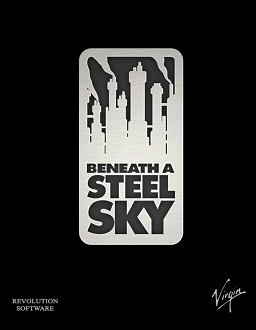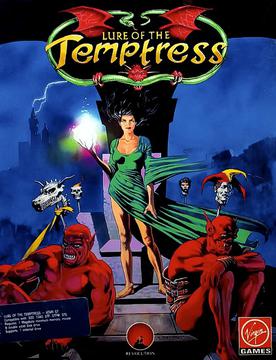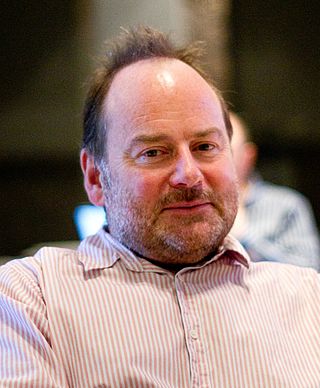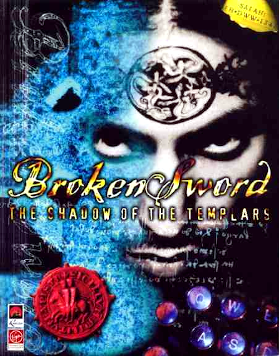
Beneath a Steel Sky is a 1994 cyberpunk science fiction point-and-click adventure game developed by British developer Revolution Software and published by Virgin Interactive Entertainment for MS-DOS and Amiga home computers. The game was made available as freeware – and with the source code released – for PC platforms in 2003. Set in a dystopian future, the player assumes the role of Robert Foster, who was stranded in a wasteland known as "the Gap" as a child and adopted by a group of local Aboriginals, gradually adjusting to his life in the wilderness. After many years, armed security officers arrive, killing the locals and taking Robert back to Union City. He escapes and soon uncovers the corruption which lies at the heart of society.

Revolution Software Limited is a British video game developer based in York, founded in 1989 by Charles Cecil, Tony Warriner, David Sykes, and Noirin Carmody.
Broken Sword is a series of adventure games. The first game in the series, Broken Sword: The Shadow of the Templars, was released and developed in 1996 by British developer Revolution Software. Its sequel, Broken Sword II: The Smoking Mirror, was released a year later, and was followed by Broken Sword: The Sleeping Dragon in 2003, Broken Sword: The Angel of Death in 2006, and Broken Sword 5: The Serpent's Curse in 2013. A remake of the first game in the series, known as Broken Sword: Shadow of the Templars – The Director's Cut, was released in 2009, and a remake of the second game in the series, Broken Sword: The Smoking Mirror – Remastered, in 2010 for iOS devices; other platforms followed in 2011.
Rolf Saxon is an American actor. He is well known for his voice over work in video games, movies and TV shows.

Lure of the Temptress is a point-and-click adventure game published by Virgin Interactive Entertainment in June 1992 for Atari ST, MS-DOS, and Amiga. It was the first game developed by Revolution Software and uses their proprietary Virtual Theatre engine. The player assumes the role of Diermot, a young peasant who has to overthrow an evil sorceress. The game was well-received and re-released as freeware on April 1, 2003.

The Virtual Theatre is a computer game engine designed by Revolution Software to produce adventure games for computer platforms. The engine allowed their team to script events, and move animated sprites against a drawn background with moving elements using a point-and-click style interface. Upon its first release, it rivaled competing engines like LucasArts' SCUMM and Sierra's Creative Interpreter, due to its then high level of artificial intelligence. The engine was first proposed in 1989, while the first game to use it, Lure of the Temptress, was released in 1992, followed by Beneath a Steel Sky (1994), Broken Sword: The Shadow of the Templars (1996) and Broken Sword II: The Smoking Mirror (1997).

Charles Cecil is a British video game designer and co-founder of Revolution Software. His family lived in the Democratic Republic of the Congo when he was still very young, but was evacuated two years after Mobutu Sese Seko's coup d'état. He studied at Bedales School in Hampshire, England. In 1980 he began his studies in Engineering Manufacture and Management at Manchester University, where he met student Richard Turner who invited him to write text adventures for Artic Computing. After completing his degree in 1985 he decided to continue his career in game development and became director of Artic. The following year he established Paragon Programming, a game development company working with British publisher U.S. Gold. In 1987 he moved into publishing as a software development manager for U.S. Gold. A year later he was approached by Activision and was offered the position of manager of their European development studio.

Broken Sword: The Sleeping Dragon is an adventure game released on Windows, Xbox, and PlayStation 2 in November 2003. It is the third installment in the Broken Sword series, released six years after the previous instalment, The Smoking Mirror. The Sleeping Dragon moved the series to 3D graphics, and is the only game in the series not to use a point and click interface. The player assumes the role of George Stobbart, an American patent lawyer who flies to the Congo to write a patent for a scientist who claims to have found a source of unlimited energy.

Broken Sword: The Shadow of the Templars is a 1996 point-and-click adventure game, and the first in the Broken Sword series, co-written and directed by Charles Cecil, and developed by Revolution Software. The player assumes the role of George Stobbart, an American tourist in Paris, as he attempts to unravel a deep conspiracy involving a sinister cult and a hidden treasure, seeing him travel to various locations around Europe and the Middle East. The game's storyline was conceived to feature a serious tone and heavily influenced by research on Knights Templar by Cecil, but was also interlaced with humor and graphics in the style of classic animated films.

Tony Warriner is a video game designer, programmer and co-founder of Revolution Software. At a young age he started playing adventure games, when they were just text adventures. He wrote his first game, Obsidian, while he was at school and sent it to Artic Computing for consideration. Artic's director, Charles Cecil, loved the game and convinced him to license it to Artic, and then to join Artic as a programmer. At Artic he wrote, together with Adam Waring, Ultima Ratio which was published in 1987 by Firebird. In the same year he got a job at Cecil's Paragon Programming, where games from US publishers were converted to European platforms. When Cecil had left to work for U.S. Gold, Warriner started doing 8-bit programming for games. In 1988 he created Death Stalker, published by Codemasters. In the same year he joined Cascade Games, where he worked on 19 Part One: Boot Camp, Arcade Trivia Quiz, and Arcade Trivia Quiz Question Creator. In 1989 Warriner moved to Bytron Aviation Systems based in Kirmington, Lincolnshire, where he wrote software for the aviation industry, David Sykes was his fellow programmer.

Broken Sword II: The Smoking Mirror is a point-and-click adventure video game originally released on Microsoft Windows and PlayStation in 1997. It was re-released on Microsoft Windows, OS X and iOS as a remastered edition in 2010 and on Android in 2012. It is the second installment in the Broken Sword series, and the first game in the series that does not follow the Knights Templar storyline. The player assumes the role of George Stobbart, a young American who is an eyewitness to the kidnapping of his girlfriend Nicole Collard.
Broken Sword may refer to:

Darksiders is a 2010 hack and slash action-adventure video game developed by Vigil Games and published by THQ. The game’s inspiration is from the Four Horsemen of the Apocalypse, with the player taking the role of the horseman War. The game was released for the PlayStation 3 and Xbox 360 on January 5, 2010 in North America, January 7 in Australia, January 8 in Europe, and March 18 in Japan. The Microsoft Windows version was released in North America and Australia on September 23, and in Europe on September 24. A parallel sequel, Darksiders II, was released on August 14, 2012.

Borys Michał Szyc-Michalak is a Polish film and theatre actor and musician.

Universomo Ltd. was a Finnish video game developer based in Tampere, Finland, founded in 2002, and acquired by THQ on May 9, 2007. Universomo also had offices in Helsinki, Finland and San Diego, United States. The studio focused on games for mobile phones, the iPhone and the N-Gage. On January 12, 2010, THQ announced the Nintendo DS title Beat City, developed by Universomo, marking the developer's first entry to the handheld gaming market.

Steve Ince is a British writer and game designer, known for his work on Revolution Software titles such as the Broken Sword series, and is working on a freelance basis.

Broken Sword 5: The Serpent's Curse is the fifth title in the Broken Sword series of adventure video games, developed and published by Revolution Software, for Microsoft Windows, OS X, Linux, PlayStation Vita, Xbox One, PlayStation 4, Nintendo Switch, Android and iOS. The game was released in two episodes: the first was made available on 4 December 2013; the second was released on 17 April 2014 for Microsoft Windows, OS X and Linux. The Serpent's Curse was announced on 23 August 2012, along with a Kickstarter project; it was launched for the development of the game, which had been self-funded until the launch, to be completed. The game is presented in HD and returns to the series' 2D roots, with 3D characters pre-rendered and saved in 2D frames. The majority of the funding for the game was raised through Kickstarter, more than $771,000 of the requested $400,000 were raised, and together with PayPal donations, over $823,000.

The Goat Puzzle, also known as The Infamous Goat Puzzle, The Infamous Goat, The Wretched Goat, The Goat of Lochmarne, or simply The Goat, is a puzzle featured in Revolution Software's 1996 point and click adventure game Broken Sword: The Shadow of the Templars. In the puzzle, protagonist George Stobbart must gain access to an underground dig located in a castle in Lochmarne, Ireland, by avoiding getting butted by a fierce goat. It is often explained to be difficult due to challenging the player in a way different from previous puzzles in the game. It is also noted by many gamers and various publications as one of the hardest video game puzzles of all time. The puzzle was simplified in The Shadow of the Templars' 2009 director's cut.

Broken Sword: Shadow of the Templars – The Director's Cut is an enhanced remake and director's cut of the classic 1996 point-and-click adventure game Broken Sword: The Shadow of the Templars developed by Revolution Software. It was released for Wii, Nintendo DS, iOS, Microsoft Windows, OS X, Android and Linux spanning 2009 to 2012. The player assumes the roles of George Stobbart and Nicole Collard, who was a pivotal but not a playable character in the original version.

Sword Coast Legends is a 2015 action role-playing game. The game is set within the universe of Forgotten Realms, a campaign setting of Dungeons & Dragons.



















